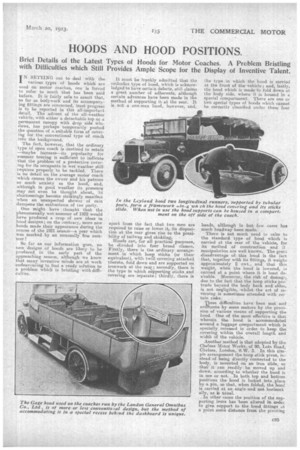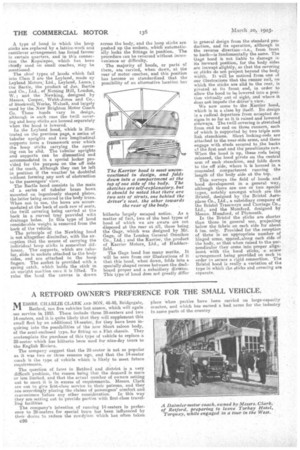HOODS AND HOOD POSITIONS.
Page 17

Page 18

If you've noticed an error in this article please click here to report it so we can fix it.
Brief Details of the Latest Types of Hoods for Motor Coaches. A Problem Bristling with Difficulties which Still Provides Ample Scope for the Display of Inventive Talent.
11N SETTING out to deal with the I various types of hoods which are need on motor coaches, one is forced to refer to much that has been said before. It is fairly safe to assert that, so far as bodywork and its accompanying fittings are concerned, least progress is to be reported in this all-important . detail. The advent of the all-weather vehicle, with either a detachable top or a permanent canopy with drop side windows, has perhaps temporarily pushed the question of a suitable form of covering for the conventional type of coach into the background.
The fact, however, that the ordinary type Of open coach is destined to retain —maybe increase—its popularity for summer touring is sufficient to indicate that the problem of a protective covering for its occupants in wet weather still require& properly to be tackled. There is no detail on the average motor coach which causes the owner and his patrons so much anxiety as the hood, and, although in good weather its presence may not even be thought about,. itS shortcomings become strikingly manifest when an unexpected shower of rain dampens the enthusiasm of tile party.
One might have thought that the phenomenally wet summer of 1922 would have produced a crop of new ideas in hood designs ; on the contrary, more new hoods made their appearance during the course of the 1921 season—a year which was marked by an unusually fine summer!
So far as our information goes, no new designs of hoods are likely to be produced in the early part of the approaching season, although we know that many inventive minds are at work endeavouring to find a ready solution to a problem which is bristling with diflieniti es, It must be frankly admitted that the orthodox type of hood, which is acknowledged to have oertain defects, still claims a great number of adherents, although certain advances have been made in the method of supporting it at the rear. It is not a one-man hood, however, and, apart from the fact that two men are required to raise or lower it, its disposition at the rear gives rise to the possibility of tailwag and skidding.
Iloods can, for all practical purposes, be divided into four broad classes. Firstly, there is the -ordinary arrangement in which hoop sticks (or their equivalent), with twill -covering attached thereto, fold down and are supported on ironwork at the rear; secondly, there is the type in which supporting sticks, and covering are separate; thirdly, there is the type in which the hood is carried at th-e front of the-vehicle; and, lastly, the hood which is made to fold down at the body side, where it is housed in a special compartment. There are one or two special types of hoods which cannot he correctly 'classified under these four
heads, although in but few cases has much headway been made. _
-There is not much need to refer to the standard type of hood which is carried at the rear of the vehicle, for its method of construction and. it manipulation are well known. The great disadvantage of this hood is the fact that, together with its fittings, it weighs approximately 2 cwt., and that this weight, when the hood is lowered, is carried at a point where it is least desirable. Moreover, the risk of damage, due to the fact that the hoop sticks pri, trude beyond the body back and sides, is not negligible, whilst the act of reversing is sometimes attended with.cer tam n risks.
These difficulties have been met and ove come by some makers by the provision of various means of supporting the hood. One of the most effective is that wherein the hood is accommodated around a luggage compartment which is specially recessed in order to keep the covering within the overall length and width of the vehicle.
Another method is that adopted by the Chelsea Motor Works, of 90, Lots Road, Chelsea, London, S.W. 3. In this simple arrangement the hoop stick pivot, instead of being directly connected to the body, is mounted on an iron slide, so thatit • can readilybp, moved up and _down, according to whether the hood is in use or not. In both top and bottom positions the hood is locked into place by a pin, so that, when folded, the hood is carried at an angle' and-not horizont ally, as is usual. In other cases the position of the supporting irons has been altered in order to give support to the hood fittings ot a *Int some distance from the pivoting
A type of hood in which the hoop sticks are replaced by a lattice-work and cantilever arrangement has found favour in certain quarters, and in this connection the Kopalapso, which has been chiefly used on small coaches, may he mentioned, The chief types of hoods which fall into Class 2 are the Leyland, made ey Leyland Motors; Ltd., Leyland, Lancs. ; the Bartle, the product of Jas. Bartle and Co., Ltd., of Notting Hill, London, W.; and the Newking, designed by Messrs. Cooper, Webb-Jones and Co., of StockwellWorks, Walsall, and largely used by the New Brighton Motor Coach Co. These hoods vary in design, although is each case the twill covering and hoop sticks are housed separately when the hood is lowered.
In the Leyland hood, which is illustrated on the previous page, a series of tubular uprights and two longitudinal supports form a framework over which the hoop sticks carrying the covering can be slid. The tubular uprights and supports can be dismantled and accommodated in a special locker provided for the purpose on the off side of the coach, although they can be left in position if the weather be doubtful without forming any sort of obstruction to the passengers' view. The Bartle hood consists in the main of a series of tubular brass bows mounted on ingeniously shaped plates, the latter being secured to the body irons. When not in use, the bows are accom • modated at the back of each row of seats, the twill covering being carried at the back in a .curved tray provided witri drainage holes. In this type of hood considerable weight is removed from the back of the vehicle.
The principle of the Newking hood is not altogether dissimilar, with the excaption that the means of carrying the individual hoop sticks is somewhat different. Thesupports, which are tubular, slide in sockets attached to the body sides, and are attached to the hoop fingers. The socket is provided with a spring catch, which holds the stick in an upright position once it is lifted. To raise the hood the canvas is drawn
across the body, and the hoop sticks are pushed up the sockets, which automatically locks the fittings in position. The procedure can be reversed without inconvenience or difficulty.
The majority of hoods, or parts ef them, are carried, when down, at the rear of motor coaches, and this position has become so standardized that the possibility of an alternative location has hitherto largely escaped notice. As a matter of fact, two of the best types of hood of which we are aware are not disposed at the rear at all, these being the Gage, which was designed by Mr. Gage, of the London General Omnibus Co., Ltd. ; and the Karrier, the product of Lanier Motors, Ltd., of Ituddersfield.
The Gage hood has many merits. It will be seen from our illustrations of it that this hood, when down, folds into a specially shaped recess between the dashboard proper and a subsidiary divisionThis type of hood does not greatly differ in general design from the standard production, and its operation, although in the reverse direction—i.e., from front to back—is fundamentally the same. The Gage hood is not liable to damage ir; its forward position, for the bodysides
are inswept slightly, so that the covering or sticks do not project beyond the body
width. It will be noticed from one of our illustrations' that the run,ner rail, ou which the sticks are slid to the rear, is pivoted at its front end, in order to allow the hood to be lowered into a position virtually out of sight, and where it does not impede the driver's view. We now come to the Karrier hood, which is in a class by itself. Its design is a radical departure from accepted de signs in so far as it is raised and lowered sideways. The twill covering is stretched from end to end on three runners each of which is supported by two triple arm link stanchions. Short locking-rods are attached to the near-side arms, and these engage with studs secured to the backs ot the first seat and the penultimate row. When the hood is up, these rods being released, the hood pivots on the central arm of each stanchion, and folds down to the off side, where it is housed in a concealed compartment running the length of the body side at the top.
This surveys the field of hoods and hood development in a general way, although there are one or two special types, notably amongst which are the Bristol, designed by the Bristol Aero plane Co., Ltd., a subsidiary company of the Bristol Tramways and Carriage Co., Ltd., and the Murriford, designed by Messrs. Mumford, of Plymouth. In the Bristol the sticks are shorter than those in general use, projecting below the fabric on each side for about 6 ins. only. Provided for the reception of these is an appropriate number of hinged arms, specedsalong each side of
the body, sot-hat when raised to the Perpendicular they come into proper alignment with the hood sticks, a screw arrangement being provided on each in order to secure a rigid connection. The Bristol hood is really a variation of the type in which the sticks and covering are separate..




















































